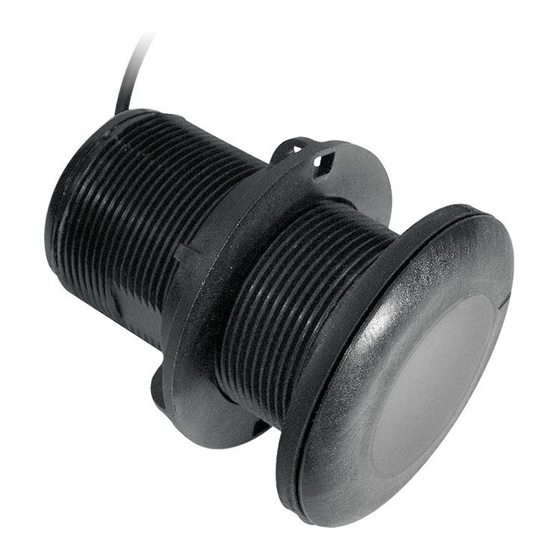
Advertisement
Quick Links
OWNER' S GUIDE
Thru-Hull, Depth
Transducer
Low Profile, Flush, and Retractable Models
WARNING: Always wear safety goggles and a dust
mask when installing to avoid personal injury.
WARNING: Immediately check for leaks when the
boat is placed in the water. Do not leave the boat
unchecked for more than three hours. Even a small
leak may allow considerable water to accumulate.
WARNING: Retractable models—The O-rings must
be intact and well lubricated to make a watertight seal.
WARNING: Retractable models—Always attach the
safety wire to prevent the insert or blanking plug from
backing out in the unlikely event that the cap nut fails
or is screwed on incorrectly.
WARNING: B117 and P319—Do not use the spacer
if there is insufficient space to tighten the nut or it is
within 11mm (1/2") of the top of the housing.
WARNING: Stainless steel housing in metal hull—
Be sure the washer contacts the hull. Do not tighten
the hull nut with the washer against the isolation
bushing, as the housing will not be firmly installed. If
necessary, sand the isolation bushing until the washer
rests against the hull.
CAUTION: Never pull, carry, or hold the transducer by
its cable; this may sever internal connections.
CAUTION: Never use solvents. Cleaners, fuel,
sealants, paint, and other products may contain strong
solvents, such as acetone, which attack many
plastics, greatly reducing their strength.
CAUTION: Plastic housing—Never use a fairing with
a plastic housing; the protruding sensor would be
vulnerable to damage from impact.
CAUTION: Metal housing—Never install a metal
housing on a vessel with a positive ground system.
CAUTION: Stainless steel housing in metal hull—
Stainless steel must be isolated from a metal hull to
prevent electrolytic corrosion. Use the isolation
bushing supplied.
IMPORTANT: Read the instructions completely
before proceeding with the installation. These
instructions supersede any other instructions in your
instrument manual if they differ.
&
INSTALLATION INSTRUCTIONS
Record the information found on the cable tag for future reference.
Part No._________________Date___________Frequency________kHz
low profile
P319
Applications
• Plastic housing recommended for fiberglass or metal hull only.
Never install a plastic transducer in a wood hull, since swelling
of the wood can possibly fracture the plastic.
• Bronze housing recommended for fiberglass or wood hull.
Never install a bronze housing in an aluminum hull, because
electrolytic corrosion will occur.
• Stainless steel housing compatible with all hull materials.
Recommended for aluminum hull to prevent electrolytic corrosion
provided the stainless steel housing is isolated from the metal hull.
• Accommodates up to a 20° deadrise angle.
Tools & Materials
Safety goggles
Dust mask
Electric drill with 10mm (3/8") or larger chuck capacity
Drill bit:
Hole saw (see table opposite)
Countersink tool (installing a flush housing)
Sandpaper
Mild household detergent or weak solvent (such as alcohol)
File (installation in a metal hull)
Marine sealant (suitable for below waterline)
Additional washer [for aluminum hull less than 6mm (1/4") thick]
Slip-joint pliers (installing a metal housing)
Grommet(s) (some installations)
Cable ties
Water-based anti-fouling paint (mandatory in salt water)
Installation in a cored fiberglass hull (see page 4):
Hole saw for hull interior:
Fiberglass cloth and resin
or Cylinder, wax, tape, and casting epoxy
Identify Your Model
The model name is printed on the cable tag.
Model
(Housing)
Low Profile:
B22, B117,
P19, P319
P5
Flush:
B21, P219, P269
Retractable:
B17, B21
P17, P217, P314
Retractable:
SS577
retractable
low profile
B17
3mm or 1/8"
(see table on this page)
Minimum
Outside Hull
Headroom
Hole Saw Size
95 mm (3-3/4")
51 mm or 2"
161mm 6-3/8")
51 mm or 2"
100 mm (4")
51 mm or 2"
200 mm (8")
51 mm or 2"
51 mm or 2"
in a fiberglass or
200 mm (8")
wood hull
57 mm or 2-1/4"
in a metal hull
flush
P219
Cored Fiberglass Hull
Hull Interior
Hole Saw Size
60 mm or 2-3/8"
60 mm or 2-3/8"
60 mm or 2-3/8"
60 mm or 2-3/8"
60 mm or 2-3/8"
Advertisement

Summary of Contents for Airmar B22
- Page 1 Headroom Hole Saw Size housing on a vessel with a positive ground system. Hole Saw Size Low Profile: B22, B117, 95 mm (3-3/4") 51 mm or 2" 60 mm or 2-3/8" CAUTION: Stainless steel housing in metal hull— P19, P319 Stainless steel must be isolated from a metal hull to 161mm 6-3/8”)
- Page 2 Best location for transducer Apply a 2mm (1/16") thick layer of marine sealant around the Copyright © 2005 Airmar Technology Corp. flange of the housing that will contact the hull and up the sidewall of the housing (see Figure 2). The sealant must extend 6mm Mounting Location (1/4") higher than the combined thickness of the hull, washer, any...
- Page 3 CAUTION: If your transducer came with a connector, do not cap nut remove it to ease cable routing. If the cable must be cut and (plastic) spliced, use Airmar’s splash-proof Junction Box No. 33-035 and safety wire follow the instructions provided. Removing the waterproof housing...
- Page 4 (replace if necessary) and lubricate them with the silicone (Europe, Middle East, Africa) Fax: +33.(0)2.23.52.06.49 lubricant supplied or petroleum jelly (Vaseline®). email: sales@airmar-emea.com ® 35 Meadowbrook Drive, Milford, New Hampshire 03055-4613, USA TECHNOLOGY CORPORATION www.airmar.com Copyright © 2006 - 2011 Airmar Technology Corp. All rights reserved.
















Need help?
Do you have a question about the B22 and is the answer not in the manual?
Questions and answers